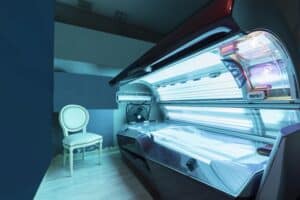
The warm glow from indoor tanning may seem harmless, but the risks can be life-changing. Research shows that using tanning beds before age 35 can increase melanoma risk by up to 75%. UV radiation damages skin cells at a DNA level, which can lead to premature aging and the development of skin cancer. Understanding these dangers is the first step toward making informed choices for your long-term health.
At ProDerm Skin & Surgery, board-certified dermatologist Dr. Sydney Proffer brings advanced training in Mohs micrographic surgery and cosmetic dermatology to help patients detect and treat skin cancers effectively. With dual fellowships from Northwestern University and certification from the American Board of Dermatology, Dr. Proffer specializes in providing precise, patient-centered care for those concerned about the effects of UV exposure.
Effects of Indoor Tanning on Skin Health
When you expose your skin to artificial UV light, the damage is more intense than natural sunlight. Tanning beds primarily emit UVA rays, which penetrate deep into the skin, damaging collagen and elastin while increasing cancer risk. Key risks include:
- Increased melanoma risk: Indoor tanning significantly raises the likelihood of developing the deadliest form of skin cancer.
- Higher incidence of non-melanoma cancers: Basal cell and squamous cell carcinomas are more common among tanning bed users.
- Premature aging: UVA exposure accelerates the breakdown of skin structure, causing wrinkles and sagging.
- Immune system suppression: UV damage can weaken your skin’s natural defense against disease.
Avoiding indoor tanning and using proper sun protection can reduce these risks and help maintain healthy skin.
How UV Rays Cause Skin Cancer
Ultraviolet radiation damages the DNA inside skin cells. When the body cannot repair this damage, abnormal cells may begin to grow uncontrollably, leading to cancer. The process can take years, but the damage is cumulative, meaning every tanning session adds to your lifetime risk. Key factors influencing skin cancer development include:
- Exposure intensity: Tanning beds often emit UV levels much higher than midday sun.
- Exposure frequency: Repeated sessions compound DNA damage.
- Skin type: Fair skin tones burn more easily, increasing vulnerability.
- Age at exposure: Younger users face higher lifetime risks.
Recognizing early warning signs, such as changes in moles or new skin growths, is essential for timely diagnosis and treatment.
Protect Your Skin’s Future with Expert Care
Your skin’s health is worth protecting. Avoid indoor tanning, use broad-spectrum sunscreen, and schedule regular skin checks to detect issues early. If you are concerned about your indoor tanning history or have noticed suspicious skin changes, contact ProDerm Skin & Surgery in Austin, TX, to schedule an appointment with Dr. Sydney Proffer.